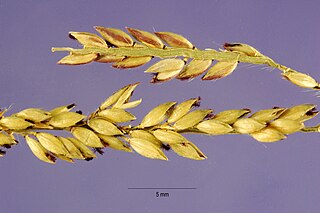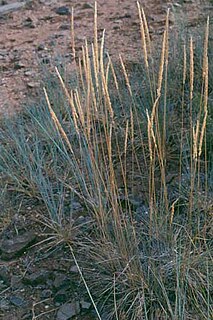| Leptothrium | |
|---|---|
| Scientific classification | |
| Kingdom: | Plantae |
| Clade: | Tracheophytes |
| Clade: | Angiosperms |
| Clade: | Monocots |
| Clade: | Commelinids |
| Order: | Poales |
| Family: | Poaceae |
| Subfamily: | Chloridoideae |
| Tribe: | Cynodonteae |
| Subtribe: | Hubbardochloinae |
| Genus: | Leptothrium Kunth 1829, conserved name, not Kunth 1816 (Orchidaceae) |
| Type species | |
| Leptothrium rigidum | |
| Synonyms [1] | |
| |
Leptothrium is a genus of African, Asian, and Neotropical plants in the grass family. [2]
A genus is a taxonomic rank used in the biological classification of living and fossil organisms, as well as viruses, in biology. In the hierarchy of biological classification, genus comes above species and below family. In binomial nomenclature, the genus name forms the first part of the binomial species name for each species within the genus.

Africa is the world's second largest and second most-populous continent. At about 30.3 million km2 including adjacent islands, it covers 6% of Earth's total surface area and 20% of its land area. With 1.2 billion people as of 2016, it accounts for about 16% of the world's human population. The continent is surrounded by the Mediterranean Sea to the north, the Isthmus of Suez and the Red Sea to the northeast, the Indian Ocean to the southeast and the Atlantic Ocean to the west. The continent includes Madagascar and various archipelagos. It contains 54 fully recognised sovereign states (countries), nine territories and two de facto independent states with limited or no recognition. The majority of the continent and its countries are in the Northern Hemisphere, with a substantial portion and number of countries in the Southern Hemisphere.

Asia is Earth's largest and most populous continent, located primarily in the Eastern and Northern Hemispheres. It shares the continental landmass of Eurasia with the continent of Europe and the continental landmass of Afro-Eurasia with both Europe and Africa. Asia covers an area of 44,579,000 square kilometres (17,212,000 sq mi), about 30% of Earth's total land area and 8.7% of the Earth's total surface area. The continent, which has long been home to the majority of the human population, was the site of many of the first civilizations. Asia is notable for not only its overall large size and population, but also dense and large settlements, as well as vast barely populated regions. Its 4.5 billion people constitute roughly 60% of the world's population.
- Species [1] [3]
- Leptothrium rigidum Kunth - Jamaica, Hispaniola, Colombia, Venezuela
- Leptothrium senegalense (Kunth) Clayton - Africa from Cape Verde to Tanzania and Egypt; Arabian Peninsula, Iran, Afghanistan, Pakistan

Jamaica is an island country situated in the Caribbean Sea. Spanning 10,990 square kilometres (4,240 sq mi) in area, it is the third-largest island of the Greater Antilles and the Caribbean. Jamaica lies about 145 kilometres (90 mi) south of Cuba, and 191 kilometres (119 mi) west of Hispaniola ; the British Overseas Territory of the Cayman Islands lies some 215 kilometres (134 mi) to the north-west.

Hispaniola is an island in the Caribbean archipelago known as the Greater Antilles. It is the most populous island in the West Indies and the region's second largest after Cuba.

Colombia, officially the Republic of Colombia, is a country largely situated in the north of South America, with land, and territories in North America. Colombia is bounded on the north by the Caribbean Sea, the northwest by Panama, the south by both Ecuador and Peru, the east by Venezuela, the southeast by Brazil and the west by the Pacific. It comprises thirty-two departments, with the capital in Bogotá.
- homonym
The name Leptothrium in its current sense was coined by Karl Sigismund Kunth in 1829. [4] The same author had used the same name earlier, in 1816, to refer to a species of orchid. [5] This appears to have been in error, with the name merely listed as a synonym, but the name was nevertheless published so it must be considered a homonym. One species name was coined in 1816 using this homonym, i.e.
In scientific nomenclature, a synonym is a scientific name that applies to a taxon that (now) goes by a different scientific name, although the term is used somewhat differently in the zoological code of nomenclature. For example, Linnaeus was the first to give a scientific name to the Norway spruce, which he called Pinus abies. This name is no longer in use: it is now a synonym of the current scientific name, Picea abies.
In biology, a homonym is a name for a taxon that is identical in spelling to another such name, that belongs to a different taxon.
- Leptothrium lineare(Jacq.) Kunth in F.W.H.von Humboldt, A.J.A.Bonpland & C.S.Kunth 1816, syn of Isochilus linearis (Jacq.) R.Br. in W.T.Aiton 1813 [6] [7]

Isochilus linearis, the narrowleaf equallip orchid, is a species of orchid native to Mexico, the West Indies, Central America and South America.











